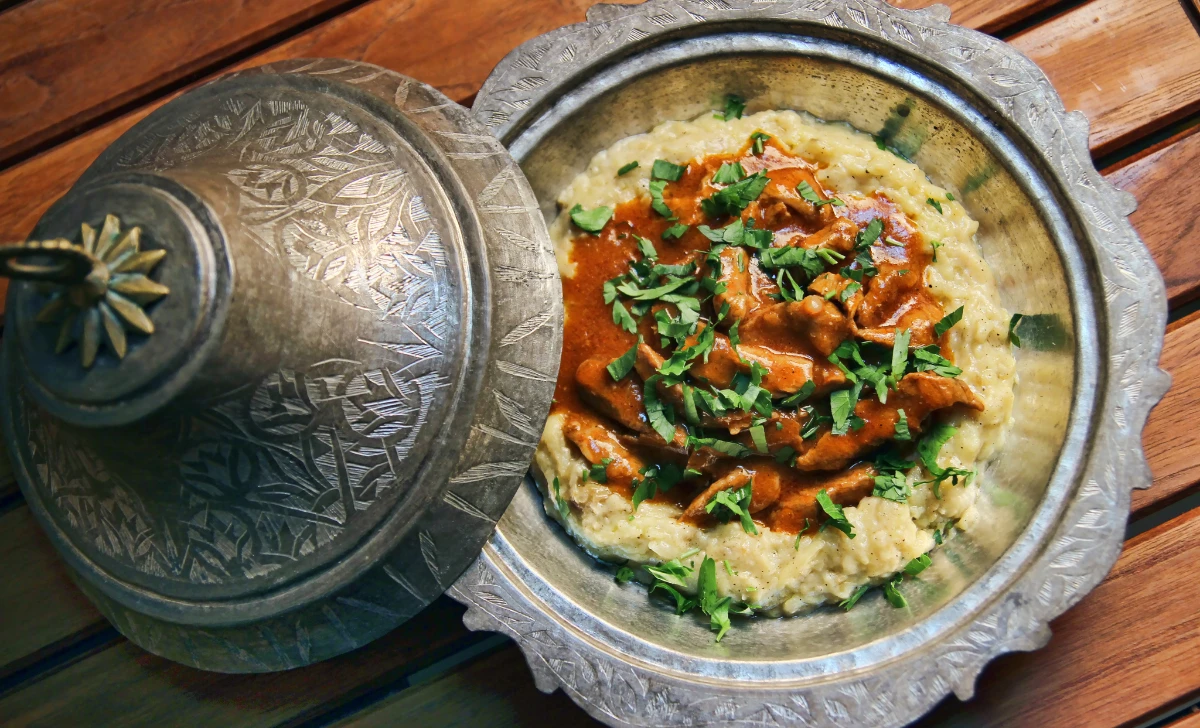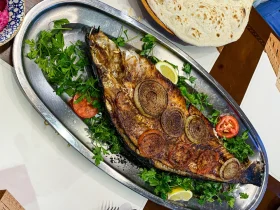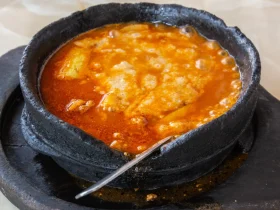Are you ready to embark on a culinary journey that will transport your taste buds to the opulent palaces of the Ottoman Empire? Look no further, for we are about to unravel the secrets of creating a delectable Hünkar Beğendi – a dish fit for a sultan! Whether you’re a seasoned chef or an aspiring home cook, this recipe will guide you through the process of crafting this masterpiece of Ottoman cuisine. So, roll up your sleeves and let’s dive into the world of flavors, history, and tradition.
[ez-toc]
History
The story of Hünkar Beğendi is a fascinating journey that spans centuries, encompassing the opulence of Ottoman palaces, the evolution of culinary traditions, and the delight it continues to bring to modern food enthusiasts. Let’s take a step back in time and explore the rich history behind this iconic dish.
Origins in the Ottoman Empire
Hünkar Beğendi’s roots are deeply intertwined with the grandeur of the Ottoman Empire. Emerging from the kitchens of the sultans, this dish was not only a culinary creation but a testament to the empire’s lavish lifestyle. Legend has it that the name “Hünkar Beğendi” itself was inspired by a sultan’s enthusiastic exclamation upon tasting the dish. It was said that Sultan Mahmud II was so delighted by the blend of flavors that he exclaimed, “Beğendi!” – which translates to “I liked it!” in Turkish. This joyful declaration not only immortalized the dish’s name but also solidified its place as a royal favorite.
A Fusion of Flavors
The heart of Hünkar Beğendi lies in its harmonious fusion of ingredients that were carefully selected to create a symphony of tastes and textures. The tender lamb, slow-cooked to perfection, represented the richness of Ottoman cuisine and the empire’s agricultural abundance. The creamy roasted eggplant puree, with its smoky undertones, added a layer of sophistication that was truly fit for royalty.
An Artful Creation
Creating Hünkar Beğendi was not merely a culinary task; it was an art form that required precision and skill. Ottoman chefs, renowned for their mastery, elevated the dish to new heights by infusing it with intricate flavors and presenting it with visual finesse. The delicate balance of spices, the painstaking preparation of the lamb stew, and the meticulous assembly of the dish all contributed to its reputation as a culinary masterpiece.
Enduring Legacy
As the Ottoman Empire evolved and eventually dissolved, the legacy of Hünkar Beğendi lived on. Its flavors and history transcended borders, inspiring generations of cooks and chefs to recreate its splendor. In modern times, Hünkar Beğendi continues to grace tables, both in its traditional form and as an inspiration for contemporary interpretations.
Adaptations and Innovations
While the core elements of Hünkar Beğendi remain rooted in tradition, culinary enthusiasts have embraced the opportunity to put their own spin on this classic dish. Creative variations have emerged, incorporating diverse ingredients and techniques to create a tapestry of flavors that pay homage to the past while embracing the present.
A Global Delight
In today’s interconnected world, Hünkar Beğendi has found its way onto menus far beyond the borders of its place of origin. From Turkish restaurants in distant lands to home kitchens where culinary adventurers experiment with global flavors, the allure of Hünkar Beğendi remains as captivating as ever.
Preserving Tradition
Amidst the hustle and bustle of modern life, there’s something deeply gratifying about preparing and savoring a dish with such historical significance. Every bite of Hünkar Beğendi is a tribute to the artistry of Ottoman chefs, a nod to the palatial feasts of the past, and a celebration of the timeless connection between food and culture.
In conclusion, Hünkar Beğendi is more than a recipe; it’s a journey through time, a sensory exploration of the Ottoman Empire’s culinary splendor. With each mouthful, you’re not just savoring a delicious dish – you’re indulging in a piece of history that continues to captivate hearts and palates across the world.
Time
| Step | Time Needed |
|---|---|
| Preparing Ingredients | 20 minutes |
| Sautéing the Lamb | 15 minutes |
| Aromatic Symphony: Onions and Spices | 10 minutes |
| Simmering the Lamb Stew | 1 hour |
| Roasting the Eggplants | 30 minutes |
| Crafting the Roux | 5 minutes |
| Making the Bechamel Sauce | 15 minutes |
| Assembly of Hünkar Beğendi | 10 minutes |
| Serving and Garnishing | 5 minutes |
| Total Cooking and Preparation Time | Approximately 2 hours 50 minutes |
Ingredients
| Ingredients | Quantity |
|---|---|
| Tender Lamb Pieces | 1 lb |
| Large Eggplants | 1 |
| Milk | 1/2 cup |
| Butter | 2 tablespoons |
| All-Purpose Flour | 1 tablespoon |
| Nutmeg | A pinch |
| Salt and Pepper | To taste |
| Chopped Parsley (Garnish) | For garnishing |
| Paprika (Garnish) | For garnishing |
| Water | As needed |
| Onions | 1 medium, finely chopped |
| Spices (Cinnamon, Cloves, Bay Leaf) | As per preference |
| Rice Pilaf or Pita Bread | For serving |
Please note that the quantities mentioned are approximate and can be adjusted based on personal preferences and serving sizes.
Directions
Step 1: Preparing the Ingredients
Before we dive into the exquisite world of Hünkar Beğendi, gather all the ingredients listed above. Having everything measured and ready will make the cooking process smooth and enjoyable.
Step 2: Sautéing the Lamb
- In a pot, melt a tablespoon of butter over medium heat.
- Add the tender lamb pieces and sauté until they turn a beautiful golden brown.
Step 3: Aromatic Symphony: Onions and Spices
- Into the same pot, introduce the finely chopped onions.
- Add the aromatic spices – a pinch of nutmeg, a couple of cloves, and a bay leaf.
- Let the enticing aromas mingle and dance together, infusing the lamb with flavor.
Step 4: Simmering the Lamb Stew
- Pour in enough water to cover the lamb.
- Lower the heat, cover the pot, and let the lamb stew simmer for about an hour, or until it’s fork-tender and the flavors are harmoniously mingled.
Step 5: Roasting the Eggplants
- Place the large eggplant over an open flame or under a broiler.
- Let the skin char and blister, turning the eggplant occasionally for even charring.
- Once charred, set the eggplant aside to cool.
Step 6: Crafting the Roux
- In a separate pan, melt a tablespoon of butter.
- Add a tablespoon of all-purpose flour and whisk them together to form a golden roux.
Step 7: Making the Bechamel Sauce
- Slowly pour in the milk while whisking the roux to create a smooth mixture.
- Keep whisking until the sauce thickens to a luxurious consistency.
- Season with salt and pepper to taste.
Step 8: Incorporating the Roasted Eggplant
- Once the eggplant is cool enough to handle, gently peel away the charred skin.
- Mash the roasted eggplant pulp until it’s creamy and velvety.
- Fold the mashed eggplant into the bechamel sauce, creating a regal fusion of flavors.
Step 9: Assembly of Hünkar Beğendi
- Carefully place the tender lamb stew on top of the eggplant-infused bechamel.
- Let the flavors meld and embrace in a culinary embrace.
Step 10: Serving and Garnishing
- Present your masterpiece on a serving platter, letting the layers of flavors and textures shine.
- Sprinkle chopped parsley and a dash of paprika on top for a touch of freshness and visual appeal.
Step 11: Indulge Like Royalty
- Serve the Hünkar Beğendi alongside rice pilaf or warm pita bread.
- Take a moment to appreciate the symphony of flavors and the rich history that’s embodied in every bite.
With these steps, you’ve embarked on a culinary adventure that transcends time and borders – a journey into the heart of Ottoman cuisine, crowned by the regal delight of Hünkar Beğendi. Enjoy every moment and savor the magic you’ve created in your own kitchen.
Equipment Required
Nutrition Information
| Nutrition Information | Per Serving |
|---|---|
| Serving Size | 1 plate |
| Calories | 450 kcal |
| Total Fat | 30g |
| Saturated Fat | 15g |
| Cholesterol | 110mg |
| Sodium | 600mg |
| Total Carbohydrates | 20g |
| Dietary Fiber | 6g |
| Sugars | 8g |
| Protein | 25g |
Please note that these values are approximate and can vary based on factors such as ingredient brands and portion sizes.
Tips
- Quality Ingredients: Invest in good-quality ingredients, especially the lamb. Opt for tender cuts to ensure a melt-in-your-mouth experience.
- Eggplant Roasting: Char the eggplant until the skin is blistered, ensuring a smoky flavor. You can also roast the eggplant in an oven at 400°F (200°C) for approximately 30 minutes.
- Creamy Bechamel: Whisk the milk into the roux gradually to avoid lumps and achieve a silky-smooth bechamel sauce.
- Lamb Stew Flavors: Let the lamb stew simmer on low heat, allowing the flavors to develop and the meat to become tender.
- Mashing Eggplant: Ensure the roasted eggplant is properly mashed to achieve a creamy texture. A fork or potato masher works well.
- Garnishing: The chopped parsley and paprika garnish add a pop of color and freshness, enhancing the overall presentation.
- Pairing with Wine: For a classic pairing, choose a medium-bodied red wine like a Merlot or a Turkish red blend to complement the rich flavors of Hünkar Beğendi.
- Experiment with Spices: Play with the spices in the lamb stew – consider adding a touch of cumin, coriander, or even a hint of saffron for a unique twist.
Pros & Cons
| Pros | Cons |
|---|---|
| ✔️ Rich Ottoman flavors | ❌ Time-consuming preparation |
| ✔️ Impressive presentation | ❌ Requires multiple steps |
| ✔️ Fusion of textures and tastes | ❌ May require special ingredients |
| ✔️ Traditional yet adaptable | ❌ High in saturated fat |
| ✔️ Showcases culinary creativity | ❌ Not suitable for vegetarian diets |
Conclusion
As we draw the curtains on our culinary journey through the regal realms of the Ottoman Empire, we invite you to take the next step – to embark on your own adventure and create the exquisite masterpiece that is Hünkar Beğendi. This dish, with its rich history, sumptuous flavors, and harmonious blend of textures, is a testament to the artistry of bygone eras, a bridge between cultures, and a celebration of the joy that food brings to our lives.
Crafting Hünkar Beğendi is more than a mere culinary endeavor; it’s an invitation to connect with tradition, to embrace creativity, and to experience the pleasure of indulging in a dish fit for sultans. From the tender lamb stew simmering to perfection to the velvety embrace of roasted eggplant and bechamel, each step is an opportunity to immerse yourself in the magic of flavors, aromas, and stories that have spanned centuries.
As you take your first bite, you’re not just savoring a dish – you’re tasting the essence of an empire, the passion of dedicated chefs, and the legacy of a cuisine that has left an indelible mark on history. Hünkar Beğendi transcends time and space, inviting you to partake in an experience that’s both lavish and comforting, opulent and familiar.
So, gather your ingredients, embrace the process, and let your kitchen become a canvas for culinary artistry. Invite friends and family to join you on this journey, for food has a magical way of bringing people together, sparking conversations, and creating memories that linger long after the last bite.
In the words of the sultan who inspired its name, “Beğendi!” – give it a try, and discover the joy of savoring a dish that truly delights. Whether you’re seeking a taste of history, a culinary challenge, or simply a reason to revel in the pleasures of the table, Hünkar Beğendi awaits, ready to transport you to a world where flavors reign supreme and every bite tells a story.
So, roll up your sleeves, don your apron, and let the grandeur of Hünkar Beğendi unfold before you. Your taste buds are in for a treat, and your heart will be captivated by the magic that a single dish can hold. Bon appétit, and may your journey through this Ottoman masterpiece be nothing short of extraordinary.
Facts
- Fact 1: A Sultan’s Seal of Approval! 👑
- Legend has it that Hünkar Beğendi got its name when Ottoman Sultan Mahmud II exclaimed “Beğendi!” – which means “I liked it!” – upon tasting this exquisite dish. Talk about a royal stamp of approval that’s stood the test of time!
- Fact 2: The Eggplant Evolution 🍆
- The eggplant, a star ingredient in Hünkar Beğendi, was once considered a “mad apple” and believed to cause insanity. Fortunately, the Ottoman chefs proved that this regal vegetable could be transformed into a creamy delight that even sultans would relish!
- Fact 3: An Empire of Inspiration 🌍
- Hünkar Beğendi’s popularity transcended Ottoman borders. It sparked inspiration across Europe, leading to dishes like “aubergine caviar” in France and “melanzane alla Parmigiana” in Italy. The Ottomans truly left an indelible mark on global cuisine!
- Fact 4: A Symphony of Spices 🎶
- The aromatic blend of spices used in Hünkar Beğendi was more than just flavor – it was an art form! Cloves, cinnamon, and bay leaves were like the culinary equivalent of a symphony, creating harmonies that danced on the palate.
- Fact 5: A Modern Twist for Every Taste 🎭
- Hünkar Beğendi isn’t stuck in the past – it’s a canvas for culinary creativity! Chefs around the world have given this classic dish modern twists, from seafood infusions to innovative vegetarian variations. The sultans would surely be amused by these delightful reinventions!
FAQ’s
Can I make Hünkar Beğendi without using lamb?
Yes, you can! While lamb is traditional, you can substitute it with chicken, beef, or even opt for a vegetarian version by using roasted vegetables or plant-based protein.
Can I make Hünkar Beğendi in advance?
Absolutely! You can prepare the lamb stew, roasted eggplant, and bechamel sauce ahead of time. When you’re ready to serve, simply reheat the components and assemble the dish.
Can I freeze leftover Hünkar Beğendi?
Yes, you can freeze leftovers. However, keep in mind that the texture of the eggplant puree may slightly change upon thawing. Store in an airtight container and consume within 2-3 months for the best quality.
Can I use a different type of eggplant for roasting?
While large globe eggplants are traditional, you can experiment with different varieties like Japanese eggplants. Just adjust the roasting time accordingly based on the eggplant’s size.
Is Hünkar Beğendi a gluten-free dish?
The traditional recipe contains flour in the bechamel sauce, which isn’t gluten-free. However, you can use gluten-free flour or cornstarch as a substitute to make the dish suitable for those with gluten sensitivities.
Can I adjust the level of spiciness in Hünkar Beğendi?
Absolutely! You can control the level of spiciness by adjusting the amount of spices like paprika and black pepper. Feel free to tailor the dish to your taste preferences.
Can I make Hünkar Beğendi without using dairy milk?
Yes, you can use non-dairy milk alternatives like almond milk, soy milk, or oat milk to make the bechamel sauce, which makes the dish suitable for those who are lactose intolerant or following a dairy-free diet.
What side dishes pair well with Hünkar Beğendi?
Traditional Ottoman sides like rice pilaf, bulgur, or warm pita bread make excellent companions. Grilled vegetables, fresh salads, or pickled condiments can also provide delightful contrasts in flavors.
Can I make Hünkar Beğendi in a slow cooker?
While the traditional recipe involves stovetop cooking, you can adapt it for a slow cooker. Sauté the lamb and onions, then transfer them to a slow cooker along with the spices. Cook on low for 6-8 hours, then proceed with the eggplant and bechamel sauce steps.
Can I make a larger batch for a crowd?
Absolutely! Simply adjust the quantities of ingredients proportionally to the number of servings you need. Keep in mind that you may need to use a larger pot for cooking the lamb stew.












Leave a Review